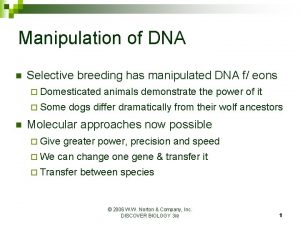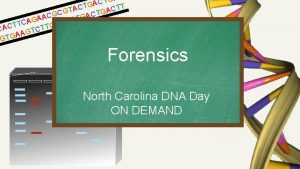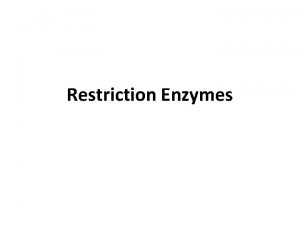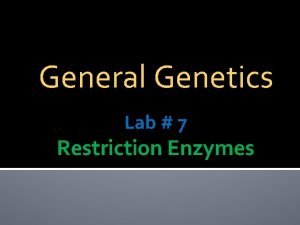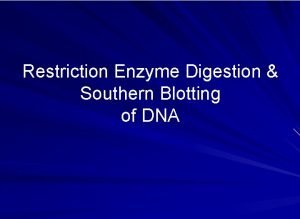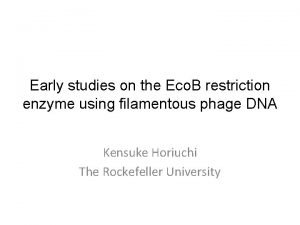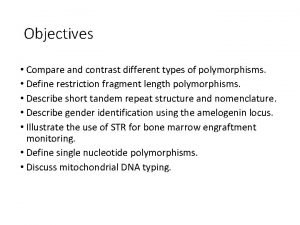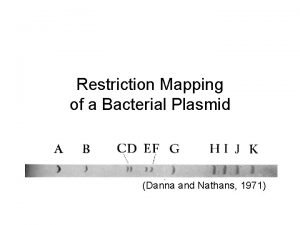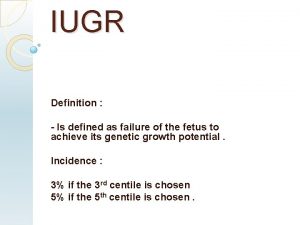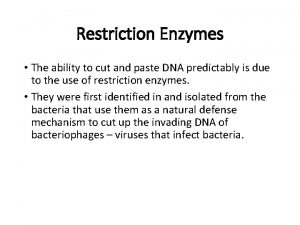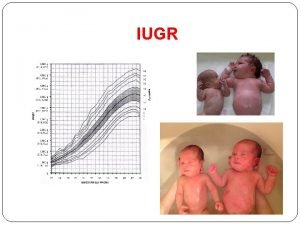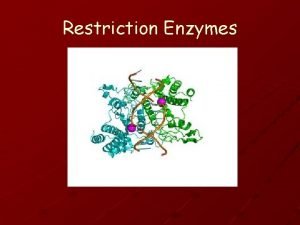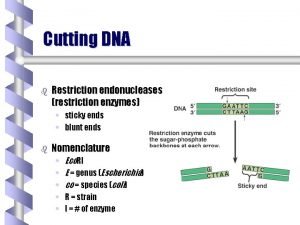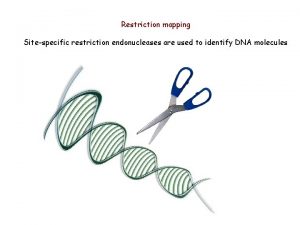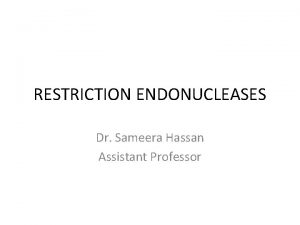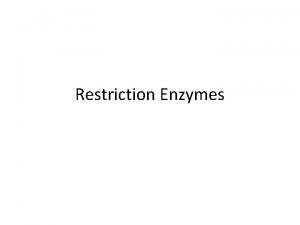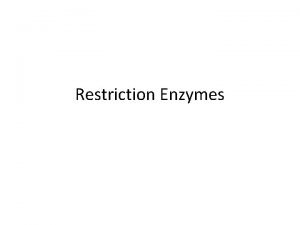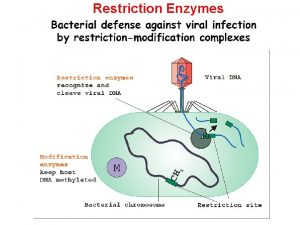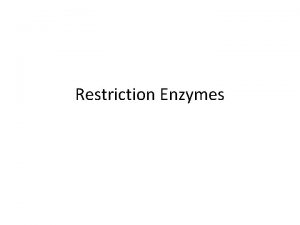RESTRICTION ENZYMES Restriction endonucleases are part of a


















- Slides: 18

RESTRICTION ENZYMES

Restriction endonucleases are part of a bacterium’s defense against invaders Restriction-modification systems allow the bacterium to distinguish self from non-self DNA Restriction: bacterial endonucleases cleave both strands of foreign DNA at specific recognition sites Modification: bacteria protect their own DNA by adding a methyl group to the recognition sites in their own DNA electron micrograph by Graham Colm of bacteriophage infecting a bacterium Type II restriction enzymes are widely used in molecular biology: enzymes cleave, but do not modify, their specific recognition sites

What are restriction enzymes? • Molecular scissors that cut double stranded DNA molecules at specific points. • Found naturally in a wide variety of prokaryotes • An important tool for manipulating DNA.

Discovery • Arbor and Dussoix in 1962 discovered that certain bacteria contain Endonucleases which have the ability to cleave DNA. • In 1970 Smith and colleagues purified and characterized the cleavage site of a Restriction Enzyme. • Werner Arbor, Hamilton Smith and Daniel Nathans shared the 1978 Nobel prize for Medicine and Physiology for their discovery of Restriction Enzymes.

Biological Role • Most bacteria use Restriction Enzymes as a defence against bacteriophages. • Restriction enzymes prevent the replication of the phage by cleaving its DNA at specific sites. • The host DNA is protected by Methylases which add methyl groups to adenine or cytosine bases within the recognition site thereby modifying the site and protecting the DNA.

Types of Restriction Enzymes Cleavage site Location of methylase Examples Type I Random Around 1000 bp away from recognition site Endonuclease and methylase located on a single protein molecule Eco. K I Eco. A I Cfr. A I Type II Specific Within the recognition site Endonuclease and methylase are separate entities Eco. R I Bam. H I Hind III Type III Random 24 -26 bp away from recognition site Endonuclease and methylase located on a single protein molecule Eco. P I Hinf III Eco. P 15 I

Recognition sites of most restriction enzymes have a twofold rotational symmetry Restriction enzymes have corresponding symmetry to facilitate recognition and usually cleave the DNA on the axis of symmetry

Restriction fragments can be blunt ended or sticky ended 5’ G A A T T C 3’ 3’ C T T A A G 5’ Sticky Ends 5’ G A T C 3’ 3’ C T A G 5’ Blunt Ends Sticky ends or blunt ends can be used to join DNA fragments. Sticky ends are more cohesive compared to blunt ends.

Isoschizomers and Neochischizomers • Restriction enzymes that have the same recognition sequence as well as the same cleavage site are Isoschizomers. • Restriction enzymes that have the same recognition sequence but cleave the DNA at a different site within that sequence are Neochizomers. Eg: Sma. I and Xma. I CCCGGG GGGCCC Xma I CCCGGG GGGCCC Sma I

Mechanism of Action Restriction Endonuclease scan the length of the DNA , binds to the DNA molecule when it recognizes a specific sequence and makes one cut in each of the sugar phosphate backbones of the double helix – by hydrolyzing the phoshphodiester bond. Specifically, the bond between the 3’ O atom and the P atom is broken.

Direct hydrolysis by nucleophilic attack at the phosphorous atom 3’OH and 5’ PO 43 - is produced. Mg 2+ is required for the catalytic activity of the enzyme. It holds the water molecule in a position where it can attack the phosphoryl group and also helps polarize the water molecule towards deprotonation.

Structure of Eco. R V endonuclease • Consists of two subunits – dimers related by two fold rotational symmetry. • Binds to the matching symmetry of the DNA molecule at the restriction site and produces a kink at the site.

Hydrogen bonding interactions between Eco. Rv and its DNA substrate

A comparison of cognate and non-specific DNA in the Ecor. V-DNA complex.

Uses of Restriction Enzymes can be used to generate a restriction map. This can provide useful information in characterizing a DNA molecule.

Uses…. Restriction Fragment Length Polymorphism is a tool to study variations among individuals & among species

Uses…. Restriction enzymes are most widely used in recombinant DNA technology.

References • Biochemistry (1995), Wiley & Sons, Inc. Voet D. and Voet J. G. • Biochemistry (2002), Freeman & Co. Berg, J. M. , Tymoczco, J. L. , Stryer, L. • An Introduction to Genetic Analysis (2000), Freeman & Co. Griffiths, A. , Miller, J. H. , Suzuki, D. T. , Lewontin, R. C. , Gelbart, W. M. • Molecular Cell Biology (2000), Freeman & Co. Lodish, Berk, Zipursky, Matsudaria, Baltimore, Darnell
 Restriction fragment length polymorphism
Restriction fragment length polymorphism Insidan region jh
Insidan region jh Restriction enzymes gel electrophoresis
Restriction enzymes gel electrophoresis Restriction enzymes
Restriction enzymes 5 examples of palindromic dna sequences
5 examples of palindromic dna sequences Restriction enzymes
Restriction enzymes Restriction enzyme
Restriction enzyme Function of restriction enzymes
Function of restriction enzymes Restriction enzymes
Restriction enzymes Rflp analysis
Rflp analysis Restriction fragment length polymorphism
Restriction fragment length polymorphism Restriction analysis
Restriction analysis Restriction mapping
Restriction mapping Symmetrical and asymmetrical iugr
Symmetrical and asymmetrical iugr Student attribute restriction uiuc
Student attribute restriction uiuc Copy and paste
Copy and paste Symmetrical growth restriction causes
Symmetrical growth restriction causes Diffusion restriction
Diffusion restriction Restriction enzyme analysis of dna ap bio lab
Restriction enzyme analysis of dna ap bio lab


